1H NMR Spin-Lattice Relaxometry of Cement Pastes with Polycarboxylate Superplasticizers
Abstract
1. Introduction
2. Materials and Methods
2.1. Materials
2.2. Preparation of PCEs
2.3. NMR Equipment and Theory
2.4. Methods
3. Results and Discussion
4. Conclusions
- (1)
- The main peak in the T1 relaxometry of cement pastes at the hydration times of 10 min, 605 min and 1210 min was delayed by polycarboxylate superplasticizers (PCEs). The delayed intensity correlated to the dosage of PCEs. The main peak in T1 relaxometry of cement pastes became shorter along with the hydration times from 10 min to 1210 min;
- (2)
- The height of the main peak in T1 relaxometry of cement pastes at these three times was decreased by PCEs. In addition to the larger area ratios of the main peak in T1 relaxometry of cement pastes at the hydration time of 1210 min due to bleeding, the decreased intensity correlated to the dosage of PCEs:
- (3)
- The main peak in T1 relaxometry of cement pastes represented the quantity of evaporable water in cement pastes. The delaying situation and the decreasing situation of the main peak was due to the dispersion mechanism and the retardation mechanism of PCEs on cement grains;
- (4)
- The total signal intensity of T1 of cement pastes at these three times was increased by PCEs. The increasing intensity correlated to the dosage of PCEs. The total signal intensity of T1 of cement pastes became smaller during the hydration process. As this intensity was proportional to the quantity of evaporable water, its changes mirrored disturbances of PCEs to situations of evaporable water in the hydration process;
- (5)
- The time-dependent evolution of weighted average T1 of cement pastes from 10 min to 1210 min was elevated by PCEs. The elevated intensity correlated to the dosage of PCEs. The curves of weighted average T1 of cement pastes were well followed by the four-stage hydration mechanism of tricalcium silicate.
Author Contributions
Funding
Conflicts of Interest
References
- Bloch, F.; Hansen, W.W.; Packard, M.E. Nuclear induction. Phys. Rev. 1946, 69, 127. [Google Scholar] [CrossRef]
- Purcell, E.M.; Torrey, H.C.; Pound, R.V. Resonance absorption by nuclear magnetic moments in a solid. Phys. Rev. 1946, 69, 37. [Google Scholar] [CrossRef]
- Faux, D.A.; McDonald, P.J. Nuclear-magnetic-resonance relaxation rates for fluid confined to closed, channel, or planar pores. Phys. Rev. E. 2018, 98, 063110. [Google Scholar] [CrossRef]
- Korb, J.P. Nuclear magnetic relaxation of liquids in porous media. New J. Phys. 2011, 13, 035016. [Google Scholar] [CrossRef]
- Monteilhet, L.; Korb, J.P.; Mitchell, J.; McDonald, P.J. Observation of exchange of micropore water in cement pastes by two-dimensional T2-T2 nuclear magnetic resonance relaxometry. Phys. Rev. E 2006, 74, 061404. [Google Scholar] [CrossRef] [PubMed]
- Valori, A.; Rodin, V.; McDonald, P.J. On the interpretation of 1H 2-dimensional NMR relaxation exchange spectra in cements: Is there exchange between pores with two characteristic sizes or Fe3+concentrations? Cem. Concr. Res. 2010, 40, 1375–1377. [Google Scholar] [CrossRef]
- Gajewicz-Jaromin, A.M.; McDonald, P.J.; Muller, A.C.A.; Scrivener, K.L. Influence of curing temperature on cement paste microstructure measured by 1H NMR relaxometry. Cem. Concr. Res. 2019, 122, 147–156. [Google Scholar] [CrossRef]
- McDonald, P.J.; Istok, O.; Janota, M.; Gajewicz-Jaromin, A.M.; Faux, D.A. Sorption, anomalous water transport and dynamic porosity in cement paste: A spatially localized 1H NMR relaxation study and a proposed mechanism. Cem. Concr. Res. 2020, 133, 106045. [Google Scholar] [CrossRef]
- Holthausen, R.S.; McDonald, P.J. On the quantifcation of solid phases in hydrated cement paste by 1H nuclear magnetic resonance relaxometry. Cem. Concr. Res. 2020, 135, 106095. [Google Scholar] [CrossRef]
- Olaru, A.M.; Blümich, B.; Adams, A. Water transport in cement-in-polymer dispersions at variable temperature studied by magnetic resonance imaging. Cem. Concr. Res. 2013, 44, 55–68. [Google Scholar] [CrossRef]
- Brocken, H.J.P.; Spiekman, M.E.; Pel, L.; Kopinga, K.; Larbi, J.A. Water extraction out of mortar during brick laying: An NMR study. Mater. Struct. 1998, 31, 49–57. [Google Scholar] [CrossRef]
- Wyrzykowski, M.; Gajewicz-Jaromin, A.M.; McDonald, P.J.; Dunstan, D.J.; Scrivener, K.L.; Lura, P. Water redistribution-microdiffusion in cement paste under mechanical loading evidenced by 1H NMR. J. Phys. Chem. C 2019, 123, 16153–16163. [Google Scholar] [CrossRef]
- Wyrzykowski, M.; McDonald, P.J.; Scrivener, K.L.; Lura, P. Water redistribution within the microstructure of cementitious materials due to temperature changes studied with 1H NMR. J. Phys. Chem. C 2017, 121, 27950–27962. [Google Scholar] [CrossRef]
- Saoût, G.L.; Lécolier, E.; Rivereau, A.; Zanni, H. Micropore size analysis in oil-well cement by proton nuclear relaxation. Magn. Reson. Imaging 2005, 23, 371–373. [Google Scholar] [CrossRef]
- Plassais, A.; Pomiès, M.P.; Lequeux, N.; Boch, P.; Korb, J.P. Micropore size analysis in hydrated cement paste by NMR. Magn. Reson. Imaging 2001, 19, 493–495. [Google Scholar] [CrossRef]
- Plassais, A.; Pomiès, M.P.; Lequeux, N.; Boch, P.; Korb, J.P.; Petit, D.; Barberon, F. Micropore size analysis by NMR in hydrated cement. Magn. Reson. Imaging 2003, 21, 369–371. [Google Scholar] [CrossRef]
- Zhou, C.S.; Ren, F.Z.; Zeng, Q.; Xiao, L.Z.; Wang, W. Pore-size resolved water vapor adsorption kinetics of white cement mortars as viewed from proton NMR relaxation. Cem. Concr. Res. 2018, 105, 31–43. [Google Scholar] [CrossRef]
- Nunes, C.; Pel, L.; Kunecký, J.; Slížková, Z. The influence of the pore structure on the moisture transport in lime plaster-brick systems as studied by NMR. Constr. Build. Mater. 2017, 142, 395–409. [Google Scholar] [CrossRef]
- Schönfelder, W.; Dietrich, J.; Märten, A.; Koping, K.; Stallmach, F. NMR studies of pore formation and water diffusion in self-hardening cut-off wall materials. Cem. Concr. Res. 2007, 37, 902–908. [Google Scholar] [CrossRef]
- Cano-Barrita, P.F.d.J.; Balcom, B.J.; Castellanos, F. Carbonation front in cement paste detected by T2 NMR measurements using a low field unilateral magnet. Mater. Struct. 2017, 50, 150. [Google Scholar] [CrossRef]
- Bortolotti, V.; Brizi, L.; Brown, R.J.S.; Fantazzini, P.; Mariani, M. Nano and sub-nano multiscale porosity formation and other features revealed by 1H NMR relaxometry during cement hydration. Langmuir 2014, 30, 10871–10877. [Google Scholar] [CrossRef] [PubMed]
- Youssef, M.; Pellenq, R.J.M.; Yildiz, B. Glassy nature of water in an ultraconfining disordered material: The case of calcium-silicate-hydrate. J. Am. Chem. Soc. 2011, 133, 2499–2510. [Google Scholar] [CrossRef] [PubMed]
- Mcdonald, P.J.; Rodin, V.; Valori, A. Characterisation of intra- and inter-C–S–H gel pore water in white cement based on an analysis of NMR signal amplitudes as a function of water content. Cem. Concr. Res. 2010, 40, 1656–1663. [Google Scholar] [CrossRef]
- Fischer, N.; Haerdtl, R.; McDonald, P.J. Observation of the redistribution of nanoscale water filled porosity in cement based materials during wetting. Cem. Concr. Res. 2015, 40, 148–155. [Google Scholar] [CrossRef]
- Cong, X.Y.; Zhou, W.; Geng, X.R.; Elchalakani, M. Low field NMR relaxation as a probe to study the effect of activators and retarders on the alkali-activated GGBFS setting process. Cem. Concr. Compos. 2019, 104, 103399. [Google Scholar] [CrossRef]
- Faure, P.; Peter, U.; Lesueur, D.; Coussot, P. Water transfers within hemp lime concrete followed by NMR. Cem. Concr. Res. 2012, 42, 1468–1474. [Google Scholar] [CrossRef]
- Yang, J.B.; Sun, Z.P.; Zhao, Y.H.; Ji, Y.L.; Li, B.Y. The water absorption-release of superabsorbent polymers in fresh cement paste: An NMR study. J. Adv. Concr. Technol. 2020, 18, 139–145. [Google Scholar] [CrossRef]
- Patural, L.; Korb, J.P.; Govin, A.; Grosseau, P.; Ruot, B.; Devès, O. Nuclear magnetic relaxation dispersion investigations of water retention mechanism by cellulose ethers in mortars. Cem. Concr. Res. 2012, 42, 1371–1378. [Google Scholar] [CrossRef]
- Cheumani, Y.A.M.; Ndikontar, M.; De Jéso, B.; Sèbe, G. Probing of wood–cement interactions during hydration of wood–cement composites by proton low-field NMR relaxomet. J. Mater. Sci. 2011, 46, 1167–1175. [Google Scholar] [CrossRef]
- Martini, F.; Borsacchi, S.; Geppi, M.; Tonelli, M.; Ridi, F.; Calucci, L. Monitoring the hydration of MgO-based cement and its mixtures with portland cement by 1H NMR relaxometry. Microporous Mesoporous Mater. 2018, 269, 26–30. [Google Scholar] [CrossRef]
- Dalas, F.; Korb, J.P.; Pourchet, S.; Nonat, A.; Rinaldi, D.; Mosquet, M. Surface relaxivity of cement hydrates. J. Phys. Chem. C 2014, 118, 8387–8396. [Google Scholar] [CrossRef]
- Gran, H.C.; Hansen, E.W. Effects of drying and freeze/thaw cycling probed by 1H-NMR. Cem. Concr. Res. 1997, 27, 1319–1331. [Google Scholar] [CrossRef]
- Blinc, R.; Burgar, M.; Lahajnar, G.; Rožmarin, M.; Rutar, V.; Kocuvan, I.; Uršič, J. NMR relaxation study of adsorbed water in cement and C3S pastes. J. Am. Ceram. Soc. 1978, 61, 35–37. [Google Scholar] [CrossRef]
- Barbič, L.; Kocuvan, I.; Blinc, R.; Lahajnar, G.; Merljak, P.; Zupančič, I. The determination of surface development in cement pastes by nuclear magnetic resonance. J. Am. Ceram. Soc. 1982, 65, 25–31. [Google Scholar] [CrossRef]
- Schreiner, L.J.; Mactavish, J.C.; Miljkovic, L.; Pintar, M.M.; Blinc, R.; Lahajnar, G.; Lasic, D.; Reeves, L.W. NMR line shape-spin-lattice relaxation correlation study of portland cement hydration. J. Am. Ceram. Soc. 1985, 68, 10–16. [Google Scholar] [CrossRef]
- Mactavish, J.C.; Miljkovic, L.; Pintar, M.M.; Blinc, R.; Lahajnar, G. Hydration of white cement by spin grouping NMR. Cem. Concr. Res. 1985, 15, 367–377. [Google Scholar] [CrossRef]
- Miljkovic, L.; Mactavish, J.C.; Jian, J.; Pintar, M.M.; Blinc, R.; Lahajnar, G. NMR study of sluggish hydration of superplasticized white cement. Cem. Concr. Res. 1986, 16, 864–870. [Google Scholar] [CrossRef]
- Lasic, D.D.; Corbett, J.M.; Jian, J.; Mactavish, J.C.; Pintar, M.M.; Blinc, R.; Lahajnar, G. NMR spin grouping in hydrating cement at 200 MHz. Cem. Concr. Res. 1988, 18, 649–653. [Google Scholar] [CrossRef]
- Blinc, R.; Lahajnar, G.; Žumer, S.; Pintar, M.M. NMR study of the time evolution of the fractal geometry of cement gels. Phys. Rev. B 1988, 38, 2873–2875. [Google Scholar] [CrossRef]
- Mactavish, J.C.; Miljkovic, L.; Peemoeller, H.; Corbett, J.M.; Jian, J.; Lasic, D.D.; Blinc, R.; Lahajnar, G.; Milia, F.; Pintar, M.M. Nuclear magnetic resonance study of hydration of synthetic white cement: Continuous quantitative monitoring of water and Ca(OH)2 during hydration. Adv. Cem. Res. 1996, 32, 155–161. [Google Scholar] [CrossRef]
- Kosmač, T.; Lahajnar, G.; Sepe, A. Proton NMR relaxation study of calcium aluminate hydration reactions. Cem. Concr. Res. 1993, 23, 1–6. [Google Scholar] [CrossRef]
- Dolinšek, J.; Apih, T.; Lahajnar, G.; Blinc, R.; Papavassiliou, G.; Pintar, M.M. Two-dimensional nuclear resonance study of a hydrated porous medium: And application to white cement. J. Appl. Phys. 1998, 87, 3535–3540. [Google Scholar] [CrossRef]
- Apih, T.; Lahajnar, G.; Sepe, A.; Blinc, R.; Milia, F.; Cvelbar, R.; Emri, I.; Gusev, B.V.; Titova, L.A. Proton spin–lattice relaxation study of the hydration of self-stressed expansive cement. Cem. Concr. Res. 2001, 31, 263–269. [Google Scholar] [CrossRef]
- Tritt-Goc, J.; Kościelski, S.; Piślewski, N. The hardening of portland cement observed by 1H spin-lattice relaxation and single-point imaging. Appl. Magn. Reson. 2000, 18, 155–164. [Google Scholar] [CrossRef]
- Nestle, N.; Zimmermann, C.; Dakkouri, M.; Kärger, J. Transient high concentrations of chain anions in hydrating cement—Indications from proton spin relaxation measurements. J. Phys. D Appl. Phys. 2002, 35, 166–171. [Google Scholar] [CrossRef]
- Sun, Z.P.; Yang, H.J.; Shui, L.L.; Liu, Y.; Yang, X.; Ji, Y.L.; Hu, K.Y.; Luo, Q. Preparation of polycarboxylate-based grinding aid and its influence on cement properties under laboratory condition. Constr. Build. Mater. 2016, 127, 363–368. [Google Scholar] [CrossRef]
- Korb, J.P. NMR and nuclear spin relaxation of cement and concrete materials. Curr. Opin. Colloid Interface Sci. 2009, 14, 192–202. [Google Scholar] [CrossRef]
- Ji, Y.L.; Pel, L.; Sun, Z.P. The microstructure development during bleeding of cement paste: An NMR study. Cem. Concr. Res. 2019, 125, 105866. [Google Scholar] [CrossRef]
- She, A.M.; Yao, W.; Wei, Y.Q. In-situ monitoring of hydration kinetics of cement pastes by low-field NMR. J. Wuhan Univ. Technol.-Mater. Sci. Ed. 2010, 25, 692–695. [Google Scholar] [CrossRef]
- Odler, I. Chapter-6: Hydration, Setting and Hardening of Portland Cement. In Lea’s Chemistry of Cement and Concrete, 4th ed.; Hewlett, P., Ed.; Elsevier Science & Technology Books: London, UK, 2004; pp. 241–297. [Google Scholar]
- Yu, Y.; Sun, Z.P.; Pang, M.; Yang, P.Q. Probing development of microstructure of early cement paste using 1H low-field NMR. J. Wuhan Univ. Technol.-Mater. Sci. Ed. 2013, 28, 963–967. [Google Scholar] [CrossRef]
- Shui, L.L.; Sun, Z.P.; Yang, H.J.; Yang, X.; Ji, Y.L.; Luo, Q. Experimental evidence for a possible dispersion mechanism of polycarboxylate-type superplasticisers. Adv. Cem. Res. 2016, 28, 287–297. [Google Scholar] [CrossRef]
- Hu, K.Y.; Sun, Z.P. Influence of polycarboxylate Superplasticizers with different functional units on the early hydration of C3A-gypsum. Materials 2019, 12, 1132. [Google Scholar] [CrossRef] [PubMed]
- Ji, Y.L.; Sun, Z.P.; Yang, J.B.; Pel, L.; Raja, A.J.; Ge, H.S. NMR study on bleeding properties of the fresh cement pastes mixed with polycarboxylate (PCE) superplasticizers. Constr. Build. Mater. 2020, 240, 117938. [Google Scholar] [CrossRef]

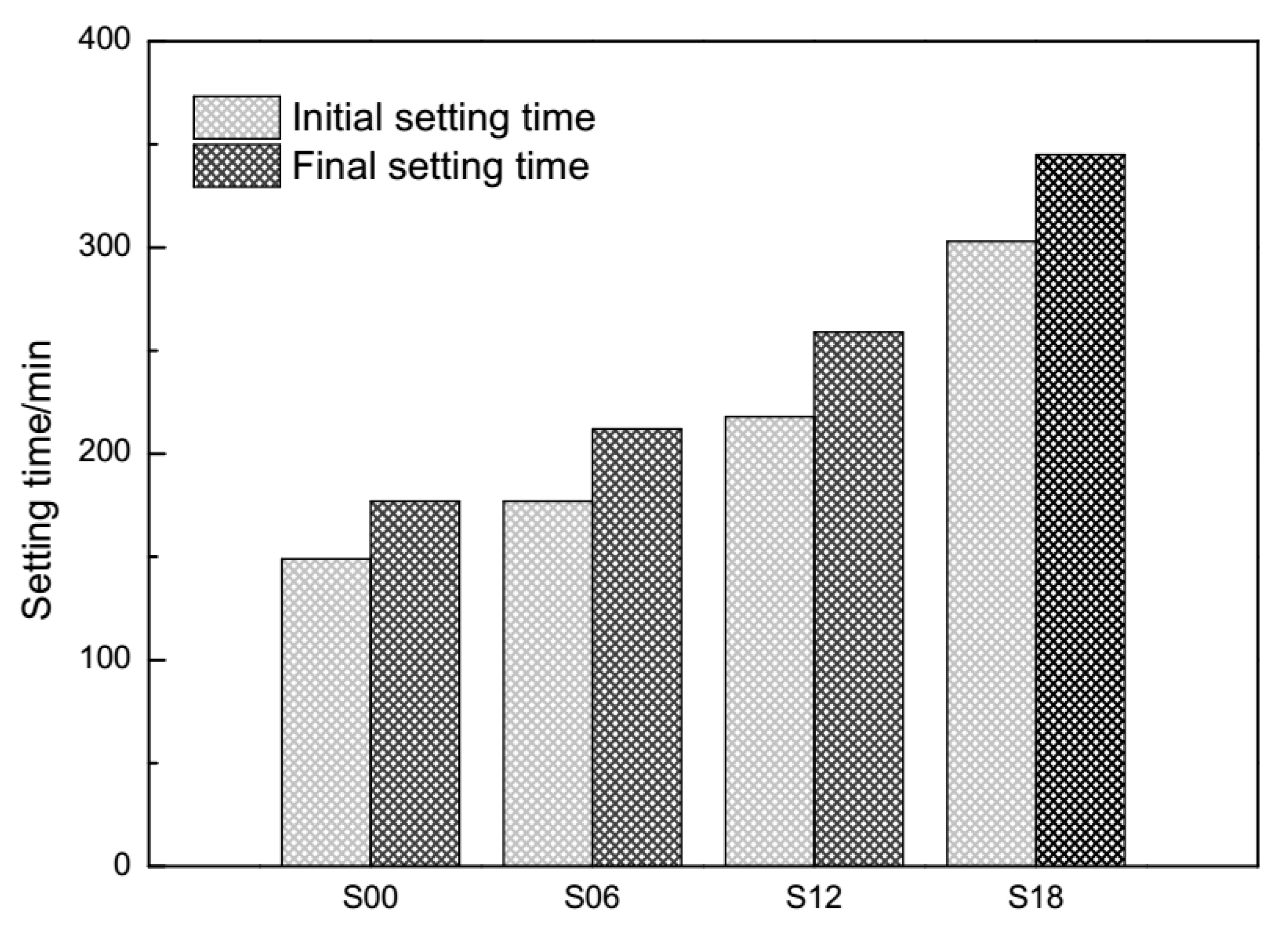
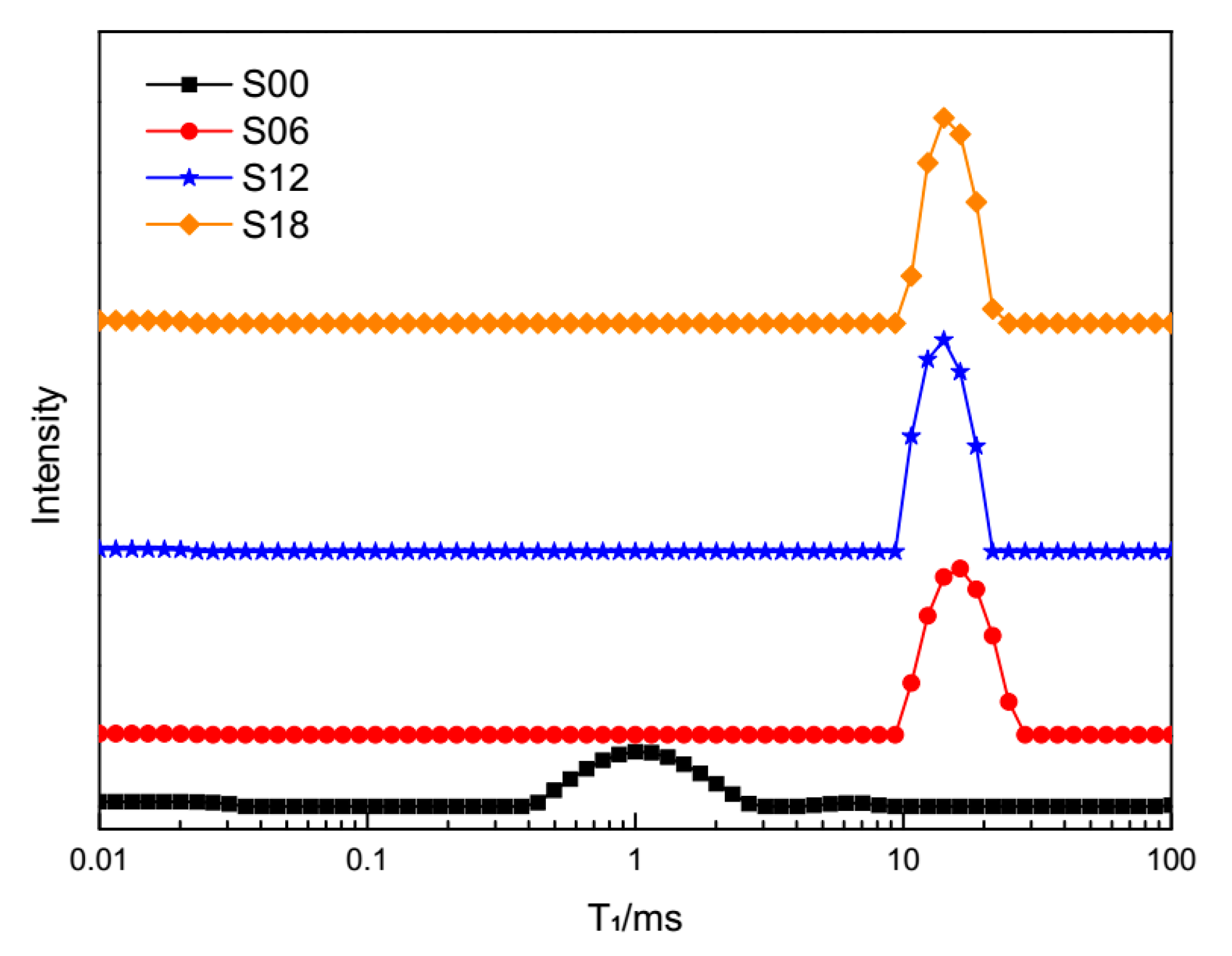
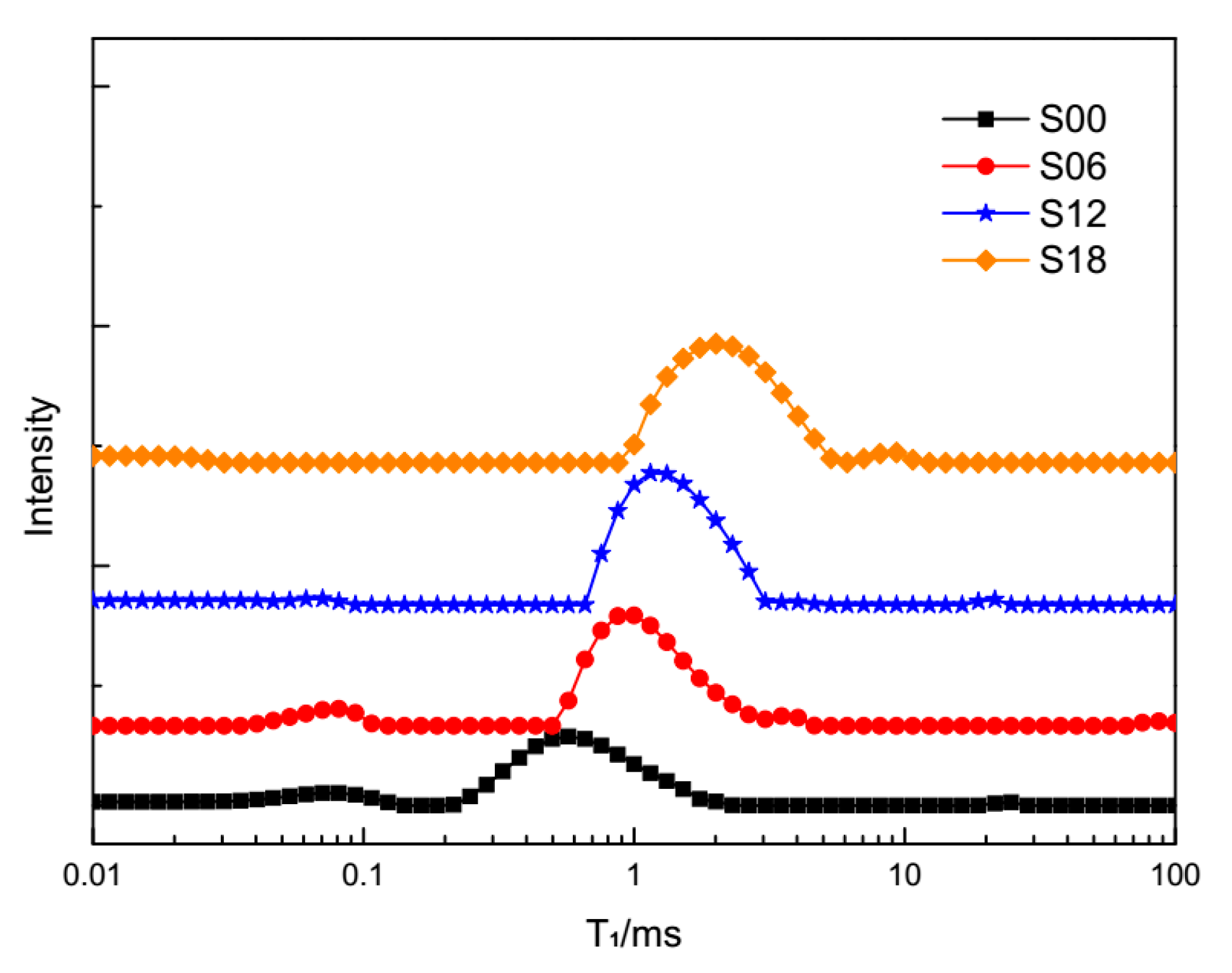

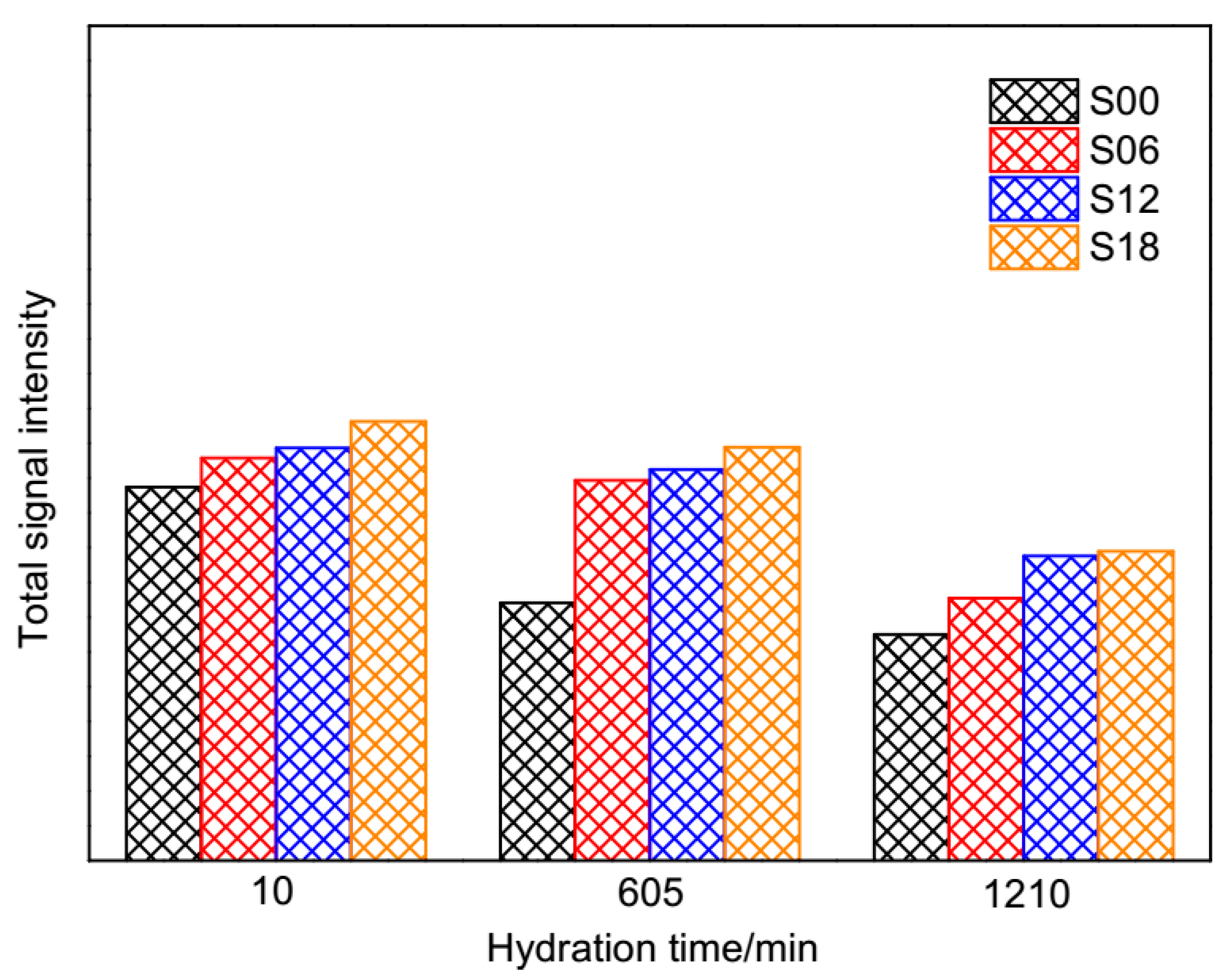
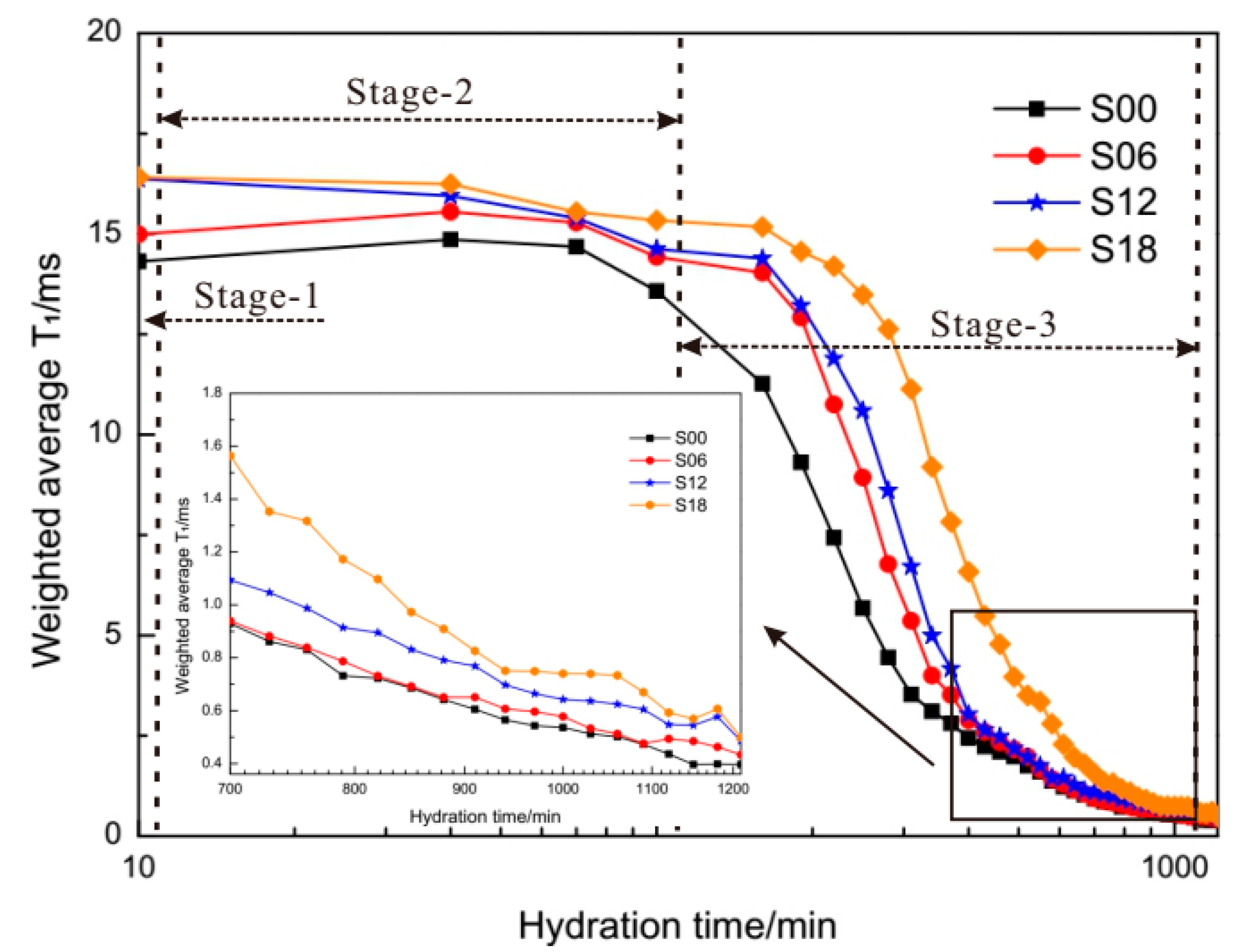
| SiO2 | CaO | Al2O3 | Fe2O3 | MgO | Na2O | K2O | TiO2 | SO3 | Loss on Ignition | |
|---|---|---|---|---|---|---|---|---|---|---|
| Cement | 21.1 | 64.3 | 5.3 | 2.6 | 1.7 | 0.2 | 0.35 | 0.3 | 1.7 | 2.45 |
| Sample | Cement (g) | Water (g) | PCE (g) |
|---|---|---|---|
| S00 | 1 | 0.28 | 0 |
| S06 | 1 | 0.28 | 0.06 |
| S12 | 1 | 0.28 | 0.12 |
| S18 | 1 | 0.28 | 0.18 |
Publisher’s Note: MDPI stays neutral with regard to jurisdictional claims in published maps and institutional affiliations. |
© 2020 by the authors. Licensee MDPI, Basel, Switzerland. This article is an open access article distributed under the terms and conditions of the Creative Commons Attribution (CC BY) license (http://creativecommons.org/licenses/by/4.0/).
Share and Cite
Pang, M.; Sun, Z.; Li, Q.; Ji, Y. 1H NMR Spin-Lattice Relaxometry of Cement Pastes with Polycarboxylate Superplasticizers. Materials 2020, 13, 5626. https://doi.org/10.3390/ma13245626
Pang M, Sun Z, Li Q, Ji Y. 1H NMR Spin-Lattice Relaxometry of Cement Pastes with Polycarboxylate Superplasticizers. Materials. 2020; 13(24):5626. https://doi.org/10.3390/ma13245626
Chicago/Turabian StylePang, Min, Zhenping Sun, Qi Li, and Yanliang Ji. 2020. "1H NMR Spin-Lattice Relaxometry of Cement Pastes with Polycarboxylate Superplasticizers" Materials 13, no. 24: 5626. https://doi.org/10.3390/ma13245626
APA StylePang, M., Sun, Z., Li, Q., & Ji, Y. (2020). 1H NMR Spin-Lattice Relaxometry of Cement Pastes with Polycarboxylate Superplasticizers. Materials, 13(24), 5626. https://doi.org/10.3390/ma13245626




